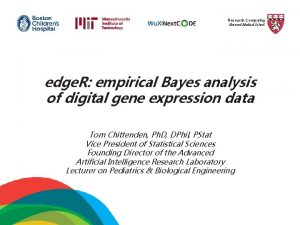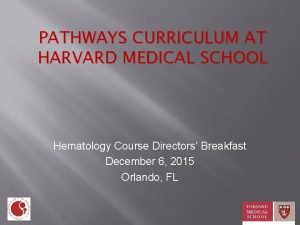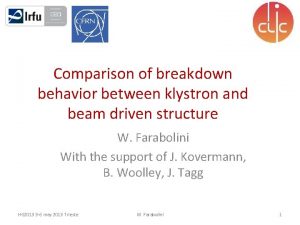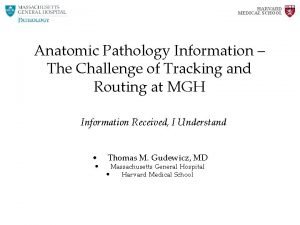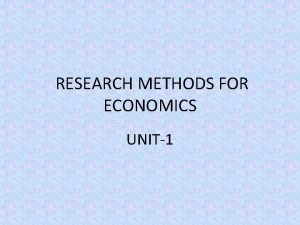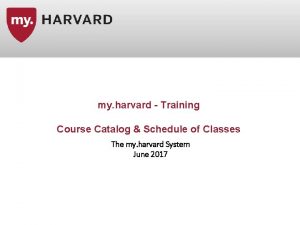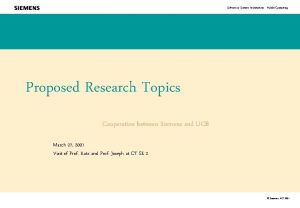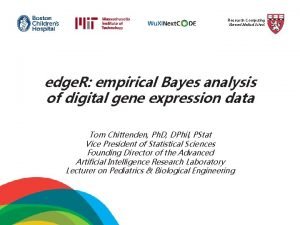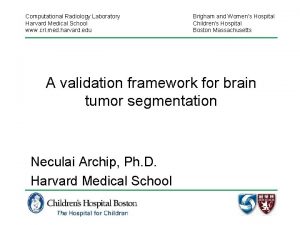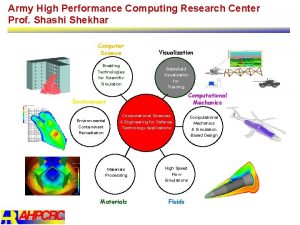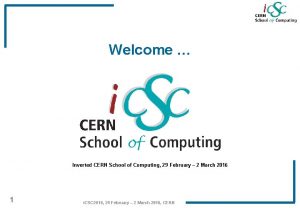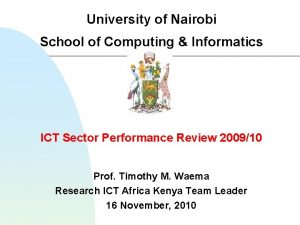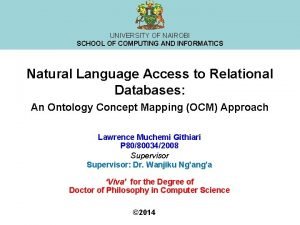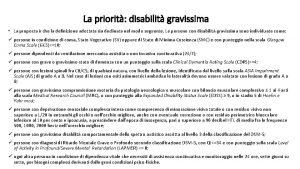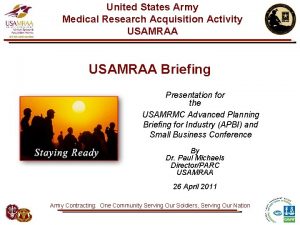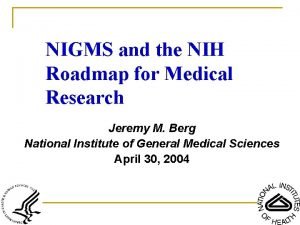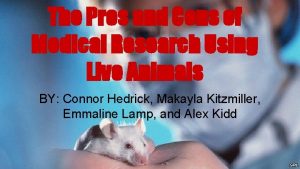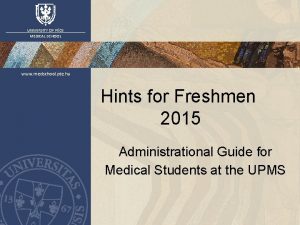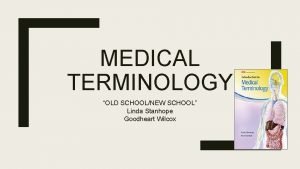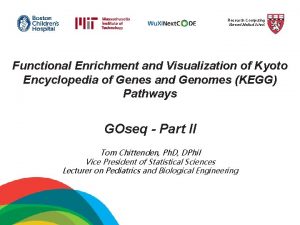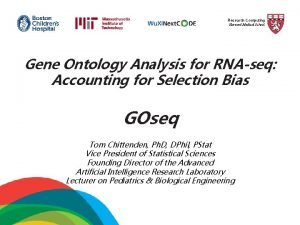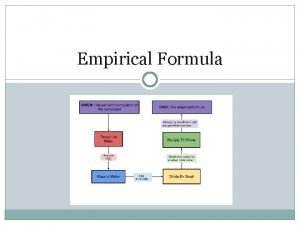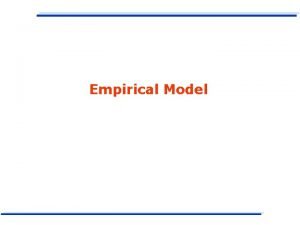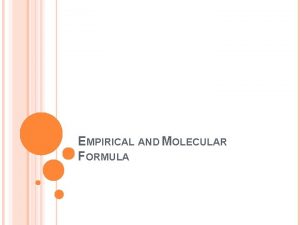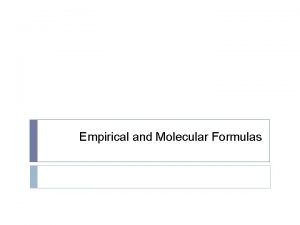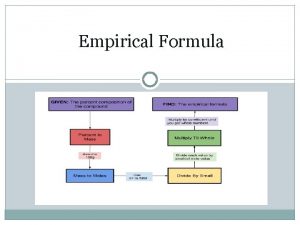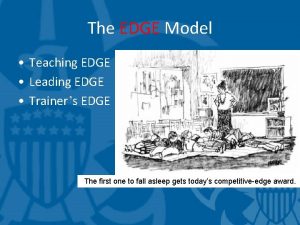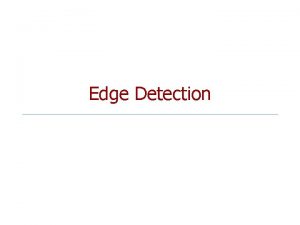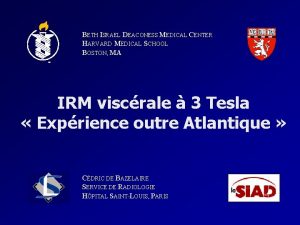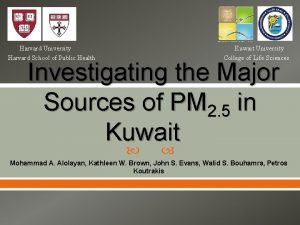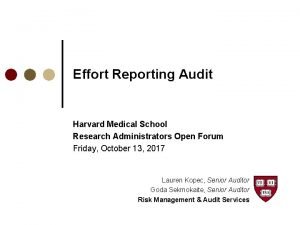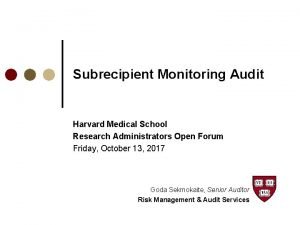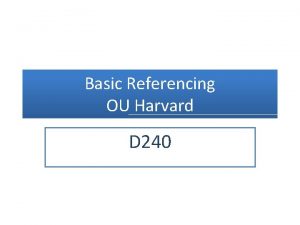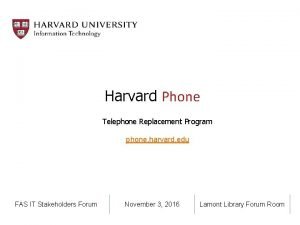Research Computing Harvard Medical School edge R empirical




































- Slides: 36

Research Computing Harvard Medical School edge. R: empirical Bayes analysis of digital gene expression data Tom Chittenden, Ph. D, DPhil, PStat Vice President of Statistical Sciences Founding Director of the Advanced Artificial Intelligence Research Laboratory Lecturer on Pediatrics & Biological Engineering

Research Computing Harvard Medical School “It’s tough to make predictions, especially about the future” Yogi Berra (Niels Bohr) “Essentially, all models are wrong, but some are useful” George Box

Research Computing Harvard Medical School Ø HMS Research Computing Course Page https: //wiki. med. harvard. edu/Orchestra/RBiostatistics. Course Ø Course information and materials will be posted two days prior to the start of each class. Ø Kristina Holton of HMS Research Computing will serve as a teaching assistant for the course.

Research Computing Harvard Medical School Statistical Framework Clinical Ontologies Genomic Ontologies Tumor samples and controls NLP Pub. Med a priori Biological Knowledge Based Feature Selection Gene expression SV Gene signatures INDELS CNV SNV Tumor markers Clinical information EMR Integrated disease signature Class Prediction Post hoc nonexperimental Validation Experimental validation Pathway Databases GO Database Pub. Med

Research Computing Harvard Medical School Part I - Unsupervised Biostatistical Analysis Data Platform Data Normalization Unsupervised Cluster & Network Analysis Hypothesis Generation RNA-Seq Data RPKM FPKM VST TMM Weighted Correlation Network Analysis (WGCNA) Unbiased Data Analysis HMS RC NGS Course R Biostatistics Course Part II - Supervised Biostatistical Analysis Data Platform RNA-Seq Data Normalization Differential Analysis TMM edge. R Gene Set Analysis Hypothesis Generation GOSeq Controls for Biases in Background Distribution & Transcript Length

Research Computing Harvard Medical School HMS Research Computing Office Hours Advanced R Programming & Biostatistics Wednesdays 1: 00 to 3: 00 pm Generating Results

Research Computing Harvard Medical School Ø TCGA breast cancer dataset Ø TCGA practice breast cancer dataset

Research Computing Harvard Medical School Part II - Supervised Differential Gene Expression and Functional Enrichment Analyses ØDifferential Gene Expression Analysis with edge. R ØFunctional Enrichment of Gene Ontology Terms with GOSeq Analysis ØFunctional Enrichment and Visualization of Kyoto Encyclopedia of Genes and Genomes (KEGG) Pathways with GOSeq Analysis and Pathview Robinson MD, Mc. Carthy DJ and Smyth GK, Bioinformatics 2010

Research Computing Harvard Medical School edge. R (empirical analysis of DGE in R) Ø edge. R is a class of statistical methods for examining differential expression of replicated count data Ø edge. R is an overdispersed Poisson model used to account for both biological and technical variability Ø edge. R uses Empirical Bayes methods to moderate the degree of overdispersion across transcripts, improving the reliability of statistical inference Robinson MD, Mc. Carthy DJ and Smyth GK, Bioinformatics 2010

Research Computing Harvard Medical School Negative Binomial Model Ø Each sample is sequenced and reads are mapped to the appropriate reference genome Ø The number of reads from sample (i) mapped to gene (g) will be denoted (ygi) Ø The set of genewise counts for sample (i) makes up the expression profile or library for that sample Ø The expected size of each count is the product of the library size and the relative abundance of that gene in that sample Yunshun Chen, Davis Mc. Carthy, Mark Robinson, Gordon K. Smyth, edge. R User’s Guide, 2014

Research Computing Harvard Medical School The data is fit with a negative binomial (NB) model: Ygi ∼ NB(Mi. Pgj , Φg) For gene (g) and sample (i) Mi = Library size (total number of reads) Φg = Dispersion pgj = Relative abundance of gene (g) in experimental group (j) to which sample (i) belongs Mean = µgi = Mi. Pgj Variance = µgi (1+µgiΦg) Note: NB distribution reduces to Poisson distribution when Φg = 0 √Φg = Biological Coefficient of Variation between samples Yunshun Chen, Davis Mc. Carthy, Mark Robinson, Gordon K. Smyth, edge. R User’s Guide, 2014

Research Computing Harvard Medical School Mean-Variance Plot >plot. Mean. Var(y) Yunshun Chen, Davis Mc. Carthy, Mark Robinson, Gordon K. Smyth, edge. R User’s Guide, 2010

Research Computing Harvard Medical School Why edge. R?

Research Computing Harvard Medical School Creating the DGEList data class Øedge. R stores data in a simple list-based data object called a DGEList ØIf the table of counts exists as a data. frame then a DGEList object can be created by >group <- c(rep("TNBC", 10), rep("Normal", 10)) >y <- DGEList(counts=x[, 1: 20], group=group) Yunshun Chen, Davis Mc. Carthy, Mark Robinson, Gordon K. Smyth, edge. R User’s Guide, 2014

Research Computing Harvard Medical School Trimmed Mean of M-values (TMM) Normalization Ø The ‘calc. Norm. Factors’ function normalizes for RNA composition by determining a set of scaling factors for the library sizes that minimize the log-fold changes between samples Ø TMM is used to compute these factors to scale original library size to the ‘effective library size, ’ which for differences in transcriptome sizes are accounted for and thus used for all downstream analyses >y <- calc. Norm. Factors(y) >y$samples Yunshun Chen, Davis Mc. Carthy, Mark Robinson, Gordon K. Smyth, edge. R User’s Guide, 2014

Research Computing Harvard Medical School Data exploration - Multi-dimensional Scaling (MDS) plot Ø The ‘plot. MDS’ function produces a multi-dimensional scaling plot of the RNA samples based on leading log-foldchange distances Ø This plot can be viewed as a type of unsupervised Clustering, somewhat similar in principle to the HCL clustering of the WGCNA in Class 1 Ø “Dimension 1 is the direction that best separates the samples, without regard to whether they are treatments or replicates. Dimension 2 is the next best direction, uncorrelated with the first, that separates the samples. ” Yunshun Chen, Davis Mc. Carthy, Mark Robinson, Gordon K. Smyth, edge. R User’s Guide, 2014

Research Computing Harvard Medical School Data exploration - Multi-dimensional Scaling (MDS) plot >plot. MDS(y) Yunshun Chen, Davis Mc. Carthy, Mark Robinson, Gordon K. Smyth, edge. R User’s Guide, 2014

Research Computing Harvard Medical School WGCNA, Peter Langfelder and Steve Horvath, 2008

Research Computing Harvard Medical School Estimating Dispersions Ø edge. R uses the quantile-adjusted conditional maximum likelihood (q. CML) method to estimate dispersions for experiments with single factor Ø q. CML calculates likelihood by conditioning on the total counts for each tag, and uses pseudo counts after adjusting for library sizes (effective library sizes) Yunshun Chen, Davis Mc. Carthy, Mark Robinson, Gordon K. Smyth, edge. R User’s Guide, 2014

Research Computing Harvard Medical School Estimating Dispersions Øq. CML common dispersion is calculated using the ‘estimate. Common. Disp’ function >y <- estimate. Common. Disp(y, verbose=TRUE) Øq. CML tagwise dispersions are calculated using the ‘estimate. Tagwise. Disp’ function >y <- estimate. Tagwise. Disp(y) Yunshun Chen, Davis Mc. Carthy, Mark Robinson, Gordon K. Smyth, edge. R User’s Guide, 2014

Research Computing Harvard Medical School Plotting Estimated Dispersions >plot. BCV(y, main = "Plot of Estimated Dispersions") Yunshun Chen, Davis Mc. Carthy, Mark Robinson, Gordon K. Smyth, edge. R User’s Guide, 2014

Research Computing Harvard Medical School Testing for DE Genes ØOnce the negative binomial model is fitted and dispersion estimates are derived, the NB exact test is used to determine differential expression for single factor experimental designs ØKnowing the conditional distribution for the sum of counts in a group, exact p-values are derived by summing over all sums of counts that have a probability less than the probability under the null hypothesis of the observed sum of counts Yunshun Chen, Davis Mc. Carthy, Mark Robinson, Gordon K. Smyth, edge. R User’s Guide, 2014

Research Computing Harvard Medical School Testing for DE Genes ØConditioning on the total pseudo-sum, the probability of observing class totals equal to or more extreme than observed can be calculated, giving an exact method of assessing differential expression ØThe 2 -tailed p-value equals the sum of the probabilities of class totals that are no more likely than those observed Mark Robinson and Gordon K. Smyth, Biostatistics, 2008

Research Computing Harvard Medical School Testing for DE Genes ØThe exact test for the negative binomial distribution has strong parallels with Fisher's exact test for the hypergeometric distribution ØHypothesis testing is performed with the ‘exact. Test’ function, and it allows for both common dispersion and tagwise dispersion approaches >et <- exact. Test(y) Yunshun Chen, Davis Mc. Carthy, Mark Robinson, Gordon K. Smyth, edge. R User’s Guide, 2014

Research Computing Harvard Medical School Plot the log-fold-changes with a smear plot, highlighting the DE genes M >plot. Smear(et, de. tags=detags, main = "Smear Plot") A Yunshun Chen, Davis Mc. Carthy, Mark Robinson, Gordon K. Smyth, edge. R User’s Guide, 2014

Research Computing Harvard Medical School Multiple Testing Correction Number of genes tested (N) False positives incidence Probability of calling 1 or more false positives by chance (100(1 -0. 95 N)) 1 1/20 5% 2 1/10 10% 20 1 64% 100 5 99. 4%

Research Computing Harvard Medical School Common Methods Ranked by Stringency Bonferroni More False Negatives Bonferroni Step-Down Westfall and Young Permutation Benjamini and Hochberg False Discovery Rate None More False Positives

Research Computing Harvard Medical School Bonferroni correction The p-value of each gene is multiplied by the number of genes in the gene list. If the corrected p-value is still below the error rate, the gene will be significant: Corrected P-value= p-value * n (number of genes in test) <0. 05 As a consequence, if testing 1000 genes at a time, the highest accepted individual p-value is 0. 00005, making the correction very stringent. With a Family-wise error rate of 0. 05 (i. e. , the probability of at least one error in the family), the expected number of false positives will be 0. 05.

Research Computing Harvard Medical School Bonferroni Step-down (Holm) correction 1) The p-value of each gene is ranked from the smallest to the largest. 2) The first p-value is multiplied by the number of genes present in the gene list. Corrected P-value= p-value * n < 0. 05 3) The second p-value is multiplied by the number of genes less 1: Corrected P-value= p-value * n-1 < 0. 05 4) The third p-value is multiplied by the number of genes less 2: Corrected P-value= p-value * n-2 < 0. 05 It follows that sequence until no gene is found to be significant.

Research Computing Harvard Medical School Bonferroni Step-down (Holm) correction Example: Let n=1000, error rate=0. 05 Gene p-value (S to L) Rank Correction Is gene significant after correction? A 0. 00002 1 0. 00002*1000 = 0. 02 < 0. 05 => Yes B 0. 00004 2 0. 00004*999 = 0. 039 < 0. 05 => Yes C 0. 00009 3 0. 00009*998 = 0. 0898 > 0. 05 => No

Research Computing Harvard Medical School Westfall and Young Permutation Ø Both Bonferroni and Holm methods are called single-step procedures, where each p-value is corrected independently. Ø The Westfall and Young permutation method takes advantage of the dependence structure between genes, by permuting all genes at the same time. Ø Westfall and Young permutation follows a step-down procedure similar to the Holm method, combined with a bootstrapping method to compute the p-value (null) distribution

Research Computing Harvard Medical School Westfall and Young Permutation 1) p-values are calculated for each gene based on the original data set and ranked. 2) The permutation method creates a pseudo-data set by dividing the data into artificial treatment and control groups. 3) p-values for all genes are computed on the pseudo-data set. 4) The successive minima of the new p-values are retained and compared to the original ones. 5) This process is repeated a large number of times, and the proportion of resampled data sets where the minimum pseudo-pvalue is less than the original p-value is the adjusted p-value.

Research Computing Harvard Medical School Benjamini and Hochberg False Discovery Rate This correction is the least stringent of all 4 options, and therefore tolerates more false positives. There will be also less false negatives. 1) The p-values of each gene are ranked from largest to smallest. 2) The largest p-value remains as it is. 3) The second largest p-value is multiplied by the total number of genes in gene list divided by its rank. Corrected p-value = p-value*(n/n-1) < 0. 05 4) The third p-value is multiplied as in step 3: Corrected p-value = p-value*(n/n-2) < 0. 05

Research Computing Harvard Medical School Benjamini and Hochberg False Discovery Rate Example: Let n=1000, error rate=0. 05 p-value Gene (L to S) Rank Correction Is gene significant after correction? A 0. 1 1000 No correction 0. 1 > 0. 05 => No B 0. 06 999 0. 06* (1000/999) = 0. 06006 > 0. 05 => No C 0. 04 998 0. 04*(1000/998) = 0. 04008 < 0. 05 => Yes

Research Computing Harvard Medical School Summary Table Correction Method Type of Error control Genes identified by chance after correction Bonferroni Family-wise error rate If error rate equals 0. 05, expects 0. 05 genes to be significant by Chance. False Discovery Rate If error rate equals 0. 05, 5% of genes considered statistically significant (that pass the restriction after correction) will be identified by chance (false positives). Bonferroni Step Down Westfall and Young Permutation Benjamini and Hochberg

Research Computing Harvard Medical School Practicum – Class 1 Øedge. R: Differential Expression Analysis of Digital Gene Expression Data Ø Example Directory Path “C: /Users/Owner/Documents/RCCG_HMS/RC_Biostatistics_Courses/Biostats_RNA-Seq/Supervised/Class 1”
 Harvard research computing
Harvard research computing Harvard medical school curriculum
Harvard medical school curriculum Rising edge and falling edge
Rising edge and falling edge Open edge computing initiative
Open edge computing initiative Harvard medical
Harvard medical Conventional computing and intelligent computing
Conventional computing and intelligent computing Types of methodologies
Types of methodologies Basic understanging of the problem is established in
Basic understanging of the problem is established in Empirical research meaning
Empirical research meaning Harvard extension course catalog
Harvard extension course catalog Harvard summer school study abroad
Harvard summer school study abroad Michael luca harvard
Michael luca harvard Hbsp cases
Hbsp cases River edge after school program
River edge after school program Bracken edge primary school
Bracken edge primary school Mobile computing research topics
Mobile computing research topics Hms research computing
Hms research computing Hms research computing
Hms research computing Army high performance computing research center
Army high performance computing research center Ptal california medical board
Ptal california medical board Gbmc medical records
Gbmc medical records Hepburn osteometric board
Hepburn osteometric board Torrance memorial lab manhattan beach
Torrance memorial lab manhattan beach Cartersville medical center medical records
Cartersville medical center medical records Cern school of computing
Cern school of computing Middle school procedure for computing gcd
Middle school procedure for computing gcd School of computing and informatics
School of computing and informatics School of computing and informatics
School of computing and informatics Jenis jenis penelitian kesehatan
Jenis jenis penelitian kesehatan Target institute of medical education and research
Target institute of medical education and research Mrc scala forza
Mrc scala forza Usa med research acq activity
Usa med research acq activity Nih roadmap for medical research
Nih roadmap for medical research Animal research pros and cons
Animal research pros and cons Animal testing for medical research pros and cons
Animal testing for medical research pros and cons Pte med school
Pte med school Medical terminology lesson plans
Medical terminology lesson plans
